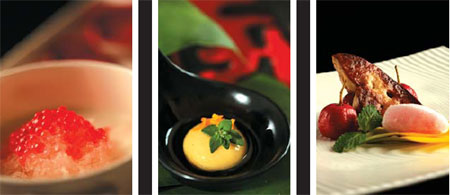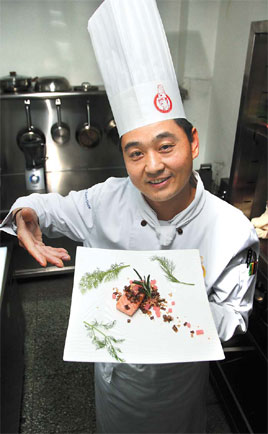|

|
|
Molecular gastronomy dishes are a feast for the eyes and tastebuds. Photos by Wang Jing and Ye Jun |
Smoke made of green tea rises from the smoked salmon and avocado roll. Shark fin in saffron soup comes in a transparent capsule. Rosy beads in bird's nest soup look like fish roe but turn out to be made of jam. These culinary stunts are the latest creations at one of Beijing's most popular Peking roast duck restaurants, Da Dong, which has introduced molecular gastronomy, providing pleasant surprises and new tasting sensations.
Molecular gastronomy is the latest fashion and much talked about in Beijing's dining scene. Brian McKenna, British chef at Shangri-La Beijing's Blu Lobster restaurant, was the first to apply the technology here. One dish, watermelon bisque, is actually served in test tubes. The cooking method is also available at several restaurants in Hong Kong and Shanghai.
|

|
|
A salmon dish takes on a new look under the magic hand of Sun Xianhou at Dadong Restaurant. |
Molecular cooking has been popular in recent years at restaurants like El Bulli in Spain, The Fat Duck in the UK, and Peirre Gagnaire in France, all of them rated Michelin three-star restaurants.
In molecular gastronomy, food materials are moleculized, re-shaped, liquefied, or gasified, and made to resemble something people are familiar with, like fish roe or egg yolk.
"While scientists are walking into the kitchen, chefs are walking into the laboratory," says Dong Zhenxiang, GM of Da Dong Roast Duck Restaurant. "The technology opens up people's minds and brings limitless possibilities to the dining table."
"The dishes look good and taste great," says Zhao Ziyun, food writer who has tried the new dishes at Da Dong. "They bring fun and interest to the meal and activate the dining atmosphere. I would certainly take friends here again."
Dong has been holding cultural exchanges with restaurants in Spain, which inspired him to spend 500,000 yuan ($72,500) purchasing machinery for molecular cooking. Now his restaurant has prepared a new menu with 15 dishes that feature molecular gastronomy.
The machines have three functions. Some use liquefied nitrogen, which is frozen to minus 170 C, to make dishes such as hawthorn fruit sorbet, and a clear tomato soup with foam that resembles beer. Some can simmer dishes at low temperatures. For example, a goose liver is slow-simmered at 60 C for two hours to create an evenly spread tender taste.
The term "molecular gastronomy" was conceived in 1988 by Hungarian physical scientist Nicholas Kurti and French chemist Herve This. But Spaniard Ferran Adria is the chef who really made it popular. His El Bulli restaurant is said to have 400,000 reservations, although its maximum reception capacity is 8,000 people a year.
Herve This put forward five goals for molecular gastronomy. He believed the technology should reveal the principles behind cooking skills of different cuisines, clarify the chemical changes between foods in cooking, research and develop new dishes, new cooking tools and methods, and make society understand the contribution of science to daily lives.
Interestingly, we have had moleculized food much longer than you might think. Candy floss, for example, is actually liquefied from granulated sugar, and chilled to be shaped like cotton.
Xue Hong, a freelancer and gastronomist based in Beijing, has argued that molecule technology should not be the orientation of Chinese cuisine.
"The Chinese have always put people at the center of gastronomy, not machines," says Xue Hong. "Chinese chefs mostly rely on their feel and experience to prepare good food. Good food to foodies has always had more to do with the people making and eating it, than with molecules of the material."
Dong says he is not applying molecular cooking for the Peking roast duck, which is what his restaurant is most famous for.
"No matter whether it is Chinese cuisine or Western cuisine, molecular gastronomy is used to beautify the dishes, improve them and better present them," says Dong. "Its role is to complement and boost our cuisine."
"The essence of our cuisine is still Chinese cuisine, which emphasizes not just taste but also texture. We will remain consistent with Chinese culinary traditions," he says. "I hope with molecular gastronomy, Chinese food can become more arty, beautiful and closer to perfection."
(China Daily? December 9, 2008)